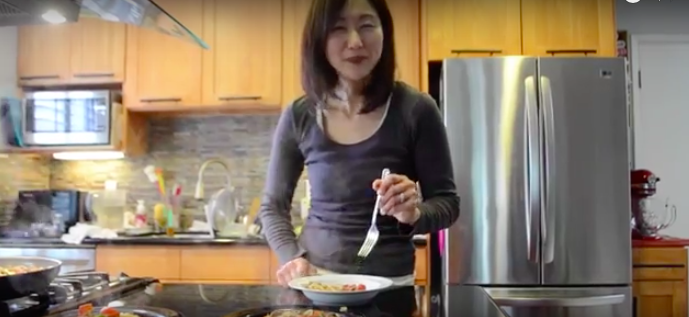t’s spaghetti and meatballs, almost.
The pasta part is typical: a navy blue cardboard box emptied into a boiling pot of water. But the meat is something different, something special. It’s Singaporean ground beef, cooked with thick slices of ginger and a heavy helping of secret sauce. Jean Lim, piano teacher and mother of senior Sarah Lim and Class of 2013 alumnus Daniel Lim, has cooked this part-American, part-Singaporean, part-Chinese dish at least twenty times, but each experience feels new.
“There’s no recipe,” she said. “It’s all kind of put together. I never know how something’s going to taste until it’s all done.”
Jean’s blended palette and mixed meals are constantly evolving as she discovers a new grocery store or makes an accidentally delicious substitution.
“There’s no recipe,” she said. “It’s all kind of put together. I never know how something’s going to taste until it’s all done.”
Jean vividly remembers the first dish she ever cooked. She was newly married and needed to eat, so she decided to whip something up. She took corned beef from a can and heated it up, adding some rice noodles and vegetables before sitting down with her husband to eat.
“He said, ‘Do you think this tastes like dog food?’” she said. “And I was like, ‘Yeah, it does.’”
Back then, Jean didn’t know that you had to fry vegetables or cook noodles before throwing them into the pan. Back in Singapore, her mother was a great cook, but Jean hadn’t wanted to learn. So she scoured bookstores to find ideas, and because she lived in Canada at the time, she created Shepherd’s Pies and lasagnas. Older women from her church would come over and teach her how to properly make salad. And as the internet became more popular, she turned to cooking websites and Martha Stewart. But she’s never been one to just stick to the recipe — she trusts her nose and her tongue over a list of instructions.
“He said, ‘Do you think this tastes like dog food?’” she said. “And I was like, ‘Yeah, it does.’”
Sauces sizzle, water runs and soft piano music plays in the background. She samples a spoon of her beef sauce and nods.
“As I’m cooking, I remember the tastes of something from my childhood,” she said. “When that happens, I’ll try and doctor it. Put more sugar, put more salt, how I remembered it tasted when my mom cooked it.”
She pauses.
“Although, my mother would not eat my food. She says it’s too Western.”
But one generation down, it’s not Western enough. Jean didn’t grow up eating pancakes, but her kids would want them at sleepovers. Though she sometimes wants to recreate the meals she enjoyed as a child, her children don’t necessarily like the same cumin or coriander flavors she grew up with. So once again, she figures things out. She adapts.
“I made the worst pancakes,” she said. “They were flat. I would sometimes buy that box of pancake mix, but I wanted to able to do it from scratch, on my own.”
She tried, but her pancakes just weren’t fluffy like her kids wanted, like the kind you’d get at IHOP. Then a week ago, when she had extra sour cream, she threw that in the mix instead of milk, and her pancakes were finally “super fluffy.”
“That’s the fun part about cooking, you just discover what you can do,” she said. “When you cook from a recipe, you’re cooking other people’s discoveries.”
Jean attributes the inherent fusion quality of her food to where she grew up in Singapore. She’d eat Indian parathas and curry for breakfast, maybe have Chinese noodles for lunch and have steak dinner. Her palette was all over the place, and it made her more open. She believes that kids growing in Cupertino will have that openness as well.
“Growing up, my classmates were Indian, Chinese, Eurasian, Malay, English,” she said. “It’s kind of like growing up here. It’s a place of immigrants. Because of that, you have a different sense of the world. It’s easy for you to live elsewhere, because you’re used to seeing people of all kinds, to not being of just one race.”
S
enior Yuhan He’s friends love her mother’s traditional Southern Chinese beef rice noodles. But He’s family had never made the dish back in China. They didn’t need to — it was available at every restaurant. But when her family came to America, she tried a few types of rice noodles, and they didn’t cut it.
“I think it tastes not so good,” she said. “I prefer spicy food, so I told my mom and she said, I can try to make it. Basically we just add everything we want.”
She didn’t have trouble finding similar ingredients for the soup, like the chili powder or sauce or the noodle-shaped rice itself, but she has been surprised by the kinds of vegetables she’s found in California.
“That tiny, tiny cabbage,” she said, referring to brussel sprouts. “I think it tastes so weird.”
She first tried the tiny, tiny cabbage at a Thanksgiving dinner at her mother’s friend’s house. She didn’t love the traditional American food, but she did like the cornbread. Since coming to America, the senior has found a connection to home in making her noodles, and a way to experience American culture through trying other foods.
S
ophomore Nathaniel Kearny could decipher half the menu from looking at the names of dishes. He could figure out another quarter from looking at pictures.
“The other part,” he said, “we just had no idea.”
When Kearny and classmates traveled to Japan in February for a language immersion field trip, he was most excited for the food. After studying the language for two years, he has developed a passion for Japanese cuisine and the trip offered him a weeklong opportunity to try authentic dishes.
The week before the trip, Kearny and his class reviewed restaurant and ordering terminology, but he was still surprised by a few customs.
First, one family restaurant he visited had a little button you could press to call over the server. He used it once, for dessert. Second, the food was definitely cheaper than the Japanese food he eats in America, and of pretty good quality. Third, the meals were small but filling, and each dish included rice.
“They always serve you rice,” he said. “If they don’t give you rice during the meal, it’s after the meal.”
Because Kearny, his classmates and his teachers made up a large group, most of their meals were already cooked by the time they got to each restaurant. But Kearny still had the chance to be adventurous, to have a taste of sesame ice cream, to order a dish based on its intricate calligraphy description hanging on the wall. And though he wasn’t crazy about every dish, he was excited to try something new
“I’m willing to try foods once,” he said. “If I don’t like it, never again. But I’ll at least try everything once.”








